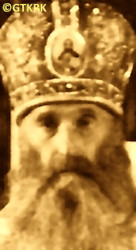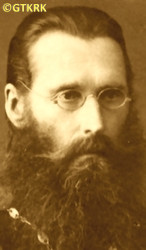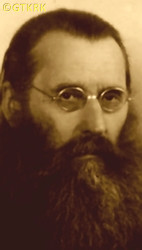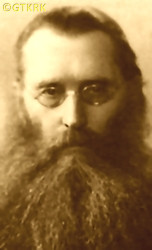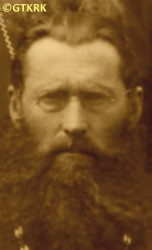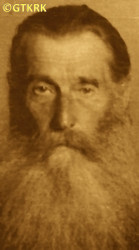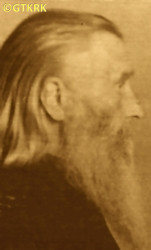Roman Catholic
St Sigismund parish
05-507 Słomczyn
85 Wiślana Str.
Konstancin deanery
Warsaw archdiocese, Poland
full list:
displayClick to display full list

searchClick to search full list by categories
wyświetlKliknij by wyświetlić pełną listę po polsku

szukajKliknij by przeszukać listę wg kategorii po polsku

Martyrology of the clergy — Poland
XX century (1914 – 1989)
personal data
surname
ZAJĄC
forename(s)
Cyril (pl. Cyryl)

function
presbiter (i.e. iereus)
creed
Eastern Orthodox Church ORmore on
en.wikipedia.org
[access: 2014.09.21]
diocese / province
Ryga OR eparchy (autonomous Latvian Orthodox Church)more on
ru.wikipedia.org
[access: 2023.06.12]
Grodno‐Brest OR eparchymore on
pl.wikipedia.org
[access: 2024.01.26]
Polotsk‐Vitebsk OR eparchymore on
drevo-info.ru
[access: 2023.07.16]
Riga‐Mitava OR eparchymore on
pl.wikipedia.org
[access: 2023.06.12]
date and place
of death
28.10.1948

ITL KarLagGuLAG slave labour camp network
today: Dolinka, Karaganda reg., Kazakhstan
more on
en.wikipedia.org
[access: 2019.10.13]
ru.wikipedia.org
[access: 2024.03.15]
details of death
On 02.09.1918 — after the overthrow of tsarism in 02.1917 and the Bolshevik coup in 11.1917, after the separatist Treaty of Brest–Litovsk on 03.03.1918, under which Bolshevik Russia withdrew from World War I and gave the Belarusian and Ukrainian lands to Germany and Austria–Hungary, after the end of the Local Russian Council Orthodox Church in Moscow — went east and took over several parishes in Polish lands. Remained there after Poland regained independence in 11.1918 and after the Polish–Russian war of 1919‐1921, which was victorious for the Poles.
In 1922 returned to his native Latvia.
In 1933, due to the discovery of large cash shortages in the Riga cathedral he managed, sentenced to 8 months' suspended prison, but acquitted at the appeal hearing. Deprived, however, of the position of rector of the Nativity of Christ cathedral.
In 1936 opposed the efforts of the Latvian Orthodox Church to autocephalize the Church in the jurisdiction of the Patriarch of Constantinople. Expelled from the Latvian Orthodox Church by the new Metropolitan of Riga and All Latvia, Abp Augustyn Peterson, began to run his own farm.
Returned to the position of rector of the Riga cathedral after 15.06.1940 — i.e. during World War II, which began with the German and Russian invasion of Poland in 09.1939 — when Russian troops entered Latvia and occupied the country.
After the German attack on 22.06.1941 on its erstwhile ally, the Russians, and the entry of German troops into Latvia, began missionary work — initially in Latvia, suffering from a year of communist, atheist Russian rule, and then from 01.12.1941 in Russia. There, with the HQ in Pskov (since the late 1920s the Holy Trinity Cathedral was closed by the communists and turned into a museum of religion and atheism), led efforts to restore the Orthodox faith in areas that had been deprived of Orthodox churches and pastors since the 1920s, including: around Veliky Novgorod and Sankt Petersburg: wherever the Germans managed to reach.
In 1943 began to collect information about the persecution of the Orthodox Church in communist Russia. Published a pastoral letter to his pastors, „Circular for the Mission”, in which ordered all parish priests to „ask believers about the data of their spiritual shepherds, details of their martyrdom, persecution of the faithful, arrests”.
In 02.1944, due to the massive bombing of Pskov by the Russians, in which thousands of the city's inhabitants died, returned to Latvia (the Russians captured Pskov on 23.07.1944). A month later moved to the town of Šiauliai in Lithuania.
Was there when, on 14.07.1944, the Germans liquidated the remains of the local ghetto, deporting c. 3,000 Jews to the German concentration camp KL Stutthof (of the c. 8,000 Jews residing in Šiauliai in 1941, c. 350‐500 survived). After the capture on 27.07.1944 of the almost completely destroyed city by the Russians — during the so‐called Šiauliai Operation — and the beginning of the Russian occupation, arrested on 18.08.1844 by agents of the genocidal Russian organization NKVD.
Transported to prison in Vilnius.
From there, on 23.08.1944, transported to the NKVD prison — prob. Lubyanka prison — in Moscow. Interrogated there and forced to write his first testimony there.
Finally, on 23‐29.09.1944, transported to the „Kresty” prison in Sankt Petersburg.
There, for the next three months, repeatedly interrogated — many hours of confrontational interrogations, of a psychological torture's nature, were also carried out at night.
Was supposed to confess to the crimes was accused of.
On 11‐15.01.1945 in Sankt Petersburg appeared before the Russian genocidal NKVD court, accused of „betrayal of the Fatherland by engaging, together with the inhabitants of the Pskov monastery, in criminal activities for the benefit of the Germans”, according to Art. 58‐1a and 58‐2 of the Russian Penal Code.
75 year‐old priest was sentenced to 20 years of forced slave labor in Russian Gulag concentration camps (together with the loss of civil rights and all property).
On 25.08.1945 transported to the ITL KarLag concentration camp, to the village of Dolinka, in Kazakhstan.
Slaved there toiling the fields and perished there, officially of „heart failure”.
cause of death
extermination
perpetrators
Russians
sites and events
ITL KarLagClick to display the description, GulagClick to display the description, Sankt Petersburg (Kresty)Click to display the description, Moscow (Lubyanka)Click to display the description, Vilnius (Lukiškės)Click to display the description, Ribbentrop‐MolotovClick to display the description, Polish‐Russian war of 1919‐1921Click to display the description
date and place
of birth
15.07.1869

Jaunā mājatoday: Madliena pog., Ogre mun., Latvia
more on
www.firmas.lv
[access: 2024.03.15]
presbyter (holy orders)
ordination
06.05.1896

positions held
15.03.1944 – 18.08.1944
priest — Šiauliaitoday: Šiauliai eld., Šiauliai dist., Šiauliai Cou., Lithuania
more on
en.wikipedia.org
[access: 2020.11.13] ⋄ St Peter and St Paul the Apostles OR church — also: head of the Internal Orthodox Mission of the authocephalus Latvian Orthodox Church in Lithuania and Latvia (till 27.07.1944)
18.02.1944 – 15.03.1944
priest — Rigatoday: Riga city mun., Latvia
more on
en.wikipedia.org
[access: 2020.07.31] ⋄ Nativity of Christ OR cathedral church
1943
protopresbiter — Russian Orthodox Church — dignity conferment
01.12.1941 – 18.02.1944
rector — Pskovtoday: Pskov city reg., Pskov oblast, Russia
more on
en.wikipedia.org
[access: 2022.07.16] ⋄ Holy Trinity OR cathedral church — head of the External Orthodox Mission of the authocephalus Latvian Orthodox Church in Pskov — in the areas of Pskov, Veliky Novgorod and Sankt Petersburg, occupied by the Germans, led to the reopening of over 220 churches, and about 84 pastors began teaching religion in schools
1940 – 11.1941
rector — Rigatoday: Riga city mun., Latvia
more on
en.wikipedia.org
[access: 2020.07.31] ⋄ Nativity of Christ OR cathedral church — also: member of the synod of the autonomous Latvian Orthodox Church, head of the commission for missions and in 08.1941‐11.1941 head of the Internal Orthodox Mission of the authocephalus Latvian Orthodox Church in Latvia
1936 – 1940
retired (i.e. „at rest”) — Jaunzemefarm n. Jaubebri
today: Bebri pog., Aizkraukle mun., Latvia
more on
lv.wikipedia.org
[access: 2024.03.15] — prob. — some sources claim that his farm was located in the Ogre district, closer to Riga than the location suggested here; sources also state that after being thrown out of the Orthodox Church (due to a protest against the autocephalization of the Latvian Orthodox Church, which was not recognized by the Russian Patriarchate), worked on a farm and on holidays „came to the cathedral in Riga, standing among the praying people”
1926 – 1936
professor — Rigatoday: Riga city mun., Latvia
more on
en.wikipedia.org
[access: 2020.07.31] ⋄ Orthodox Theological Seminary — lecturer in liturgy, practical theology and sectology; prefect at gymnasium
1929 – 1933
rector — Rigatoday: Riga city mun., Latvia
more on
en.wikipedia.org
[access: 2020.07.31] ⋄ Nativity of Christ OR cathedral church — also: 1923‐1934 editor of Lat. „Ticība un Dzīve” (Eng. „Faith and Life”) magazine
1924
mitred — Russian Orthodox Church — dignity conferment, the right to wear the liturgical headgear in the form of a four–part closed crown with images of God, the Mother of God and some saints, decorated with precious stones
1922 – 1929
priest — Rigatoday: Riga city mun., Latvia
more on
en.wikipedia.org
[access: 2020.07.31] ⋄ Nativity of Christ OR cathedral church — also: member of the synod of the autonomous Latvian Orthodox Church (from 1923), head of the commission for missions; author of part of the iconstasis in the Nativity of the Blessed Virgin Mary church in Šķilbani
01.01.1921 – 01.10.1922
parish priest — Grodnotoday: Grodno dist., Grodno reg., Belarus
more on
en.wikipedia.org
[access: 2023.01.18] ⋄ Intercession of the Blessed Virgin Mary OR cathedral church ⋄ Grodno‐Brześć OR eparchy — acting („ad interim”); also: member of the consistory of the eparchy
20.09.1918
parish priest — Rybołytoday: Zabłudów gm., Białystok pov., Podlaskie voiv., Poland
more on
en.wikipedia.org
[access: 2024.03.15] ⋄ St Cosma and St Damian the Martyrs OR parish
1918 – 1920
administrator — Kożanytoday: Juchnowiec Kościelny gm., Białystok pov., Podlaskie voiv., Poland
more on
en.wikipedia.org
[access: 2024.03.15] ⋄ Exaltation of the Holy Cross OR parish — acting („ad interim”)
1918 – 1920
administrator — Puchłytoday: Narew gm., Hajnówka pov., Podlaskie voiv., Poland
more on
en.wikipedia.org
[access: 2020.09.24] ⋄ Intercession of the Blessed Virgin Mary OR parish — acting („ad interim”)
28.08.1917 – 20.09.1918
membership — Moscowtoday: Moscow city, Russia
more on
en.wikipedia.org
[access: 2020.07.31] ⋄ Local Council of the Russian Orthodox Church, Russian Orthodox Church ⋄ Assumption of the Blessed Virgin Mary OR cathedral church — representative of the clergy of the Polotsk–Vitebsk OR eparchy (elected prob. at the local eparchial Congress of clergy, church administrators and laity, as senior advisor to the chairman of the Congress), participant in all three sessions of the Council, member of the II, III, V, VII, IX, XI, XIX of its committees
1916 – 1917
prefect — Vitebsktoday: Vitebsk reg., Belarus
more on
en.wikipedia.org
[access: 2023.01.18] ⋄ eparchial school for girls ⋄ Polotsk‐Vitebsk OR eparchy
06.05.1916
protoiereus (Eng. first priest) — Russian Orthodox Church — dignity conferment
1911 – 1916
missionary — Dzvinsktoday: Daugavpils, Daugavpils urban mun., Latvia
more on
en.wikipedia.org
[access: 2020.07.31] — on behalf of the Orthodox Missionary Society in Vitebsk, a missionary — fighting the influence of Catholicism and various sects — mainly in Latgale, Latvia, in the Polotsk–Vitebsk OR eparchy; also: prefect at the church and parish school near Lutsyn (referred to as Rus. „Банковска церковно–приходская школа”), gymnasium for girls in Vitebsk (c. 1913)
1899 – 1911
parish priest — Eržepoletoday: part of Viļaka, Viļaka pog., Balvi mun., Latvia
more on
lv.wikipedia.org
[access: 2024.03.15] ⋄ Intercession of the Blessed Virgin Mary OR parish — also: assistant dean (from 1903), member and activist of the Committee of the Orthodox Missionary Society in Vitebsk (from 1900), graduate of the Higher Missionary Course in Sankt Petersburg (1900)
c. 1897 – c. 1898
priest — Liepnatoday: Liepna pog., Balvi mun., Latvia
more on
en.wikipedia.org
[access: 2024.03.15] ⋄ St Elijah the Prophet OR church
c. 1897
priest — Balvitoday: Balvi mun., Latvia
more on
en.wikipedia.org
[access: 2021.05.20] ⋄ Assumption of the Blessed Virgin Mary OR church
priest — Vīksnatoday: Vīksna pog., Balvi mun., Latvia
more on
lv.wikipedia.org
[access: 2024.03.15] ⋄ St Vladimir the Great OR church
priest — Viļakaform.: Marienhauz
today: Viļaka pog., Balvi mun., Latvia
more on
en.wikipedia.org
[access: 2022.02.15] ⋄ Assumption of the Blessed Virgin Mary OR church
06.05.1896
presbiter (Eng. priest, i.e. iereus) — Russian Orthodox Church — priesthood cheirotonia, i.e. ordination; earlier, in the years 1891‐1896, was a teacher and psalmist in the Riga–Mitava OR eparchy
till 1891
student — Rigatoday: Riga city mun., Latvia
more on
en.wikipedia.org
[access: 2020.07.31] ⋄ philosophy and theology, Orthodox Theological Seminary
sites and events
descriptions
ITL KarLag: Russian Rus. Исправи́тельно‐Трудово́й Ла́герь (Eng. Corrective Labor Camp) ITL Rus. Карагандинский (Eng. Karagandskiy) — concentration and slave forced labor camp (within the Gulag complex) — with headquarters in the city of Karaganda, Karaganda Oblast in Kazakhstan. Founded on 17.09.1931. One of the largest in the Gulag complex. It covered an area of 300 by 200 km, with its center in the Dolynka village, c. 45 km from Karaganda. One of the tasks was to grow food, especially animal husbandry, for the emerging centers of coal mining and heavy industry in Kazakhstan. Prisoners slaved in camp workshops (metal processing, drawing, tailoring), in the production of construction materials, in a glassworks, a sugar refinery, a vegetable drying plant, in coal mines, limestone mining, and in fishing. At its peak, c. 65,000 prisoners were held there: e.g. 45,798 (01.01.1943); 50,080 (01.01.1944); 53,946 (01.01.1945); 60,745 (01.01.1947); 63,555 (01.01.1948); 65,673 (01.01.1949); 54,179 (01.01.1950); 45,675 (01.01.1951). In total, c. 1,000,000 people passed through the camp, including many women and children. Many died. It ceased operations on 27.07.1959. (more on: en.wikipedia.orgClick to attempt to display webpage
[access: 2019.10.13])
Gulag: The acronym Gulag comes from the Rus. Главное управление исправительно‐трудовых лагерей и колоний (Eng. Main Board of Correctional Labor Camps). The network of Russian concentration camps for slave labor was formally established by the decision of the highest Russian authorities on 27.06.1929. Control was taken over by the OGPU, the predecessor of the genocidal NKVD (from 1934) and the MGB (from 1946). Individual gulags (camps) were often established in remote, sparsely populated areas, where industrial or transport facilities important for the Russian state were built. They were modeled on the first „great construction of communism”, the White Sea‐Baltic Canal (1931‐1932), and Naftali Frenkel, of Jewish origin, is considered the creator of the system of using forced slave labor within the Gulag. He went down in history as the author of the principle „We have to squeeze everything out of the prisoner in the first three months — then nothing is there for us”. He was to be the creator, according to Alexander Solzhenitsyn, of the so‐called „Boiler system”, i.e. the dependence of food rations on working out a certain percentage of the norm. The term ZEK — prisoner — i.e. Rus. заключенный‐каналоармец (Eng. canal soldier) — was coined in the ITL BelBaltLag managed by him, and was adopted to mean a prisoner in Russian slave labor camps. Up to 12 mln prisoners were held in Gulag camps at one time, i.e. c. 5% of Russia's population. In his book „The Gulag Archipelago”, Solzhenitsyn estimated that c. 60 mln people were killed in the Gulag until 1956. Formally dissolved on 20.01.1960. (more on: en.wikipedia.orgClick to attempt to display webpage
[access: 2024.04.08])
Sankt Petersburg (Kresty): Russian prison in Sankt Petersburg where many Polish priests were kept captive. Many of them were also murdered there. (more on: en.wikipedia.orgClick to attempt to display webpage
[access: 2014.12.20])
Moscow (Lubyanka): Location of a murderous Russian Cheka and next GPU and NKVD (later MVD and KGB) organisations and a prison (in the basement, with 118 cells — in 1936 — of which 94 were solitary — altogether at any time up to 350 prisoners were held there and c. 2,857 in 1937) in Moscow at Lubyanka Square where Russians interrogated and murdered many political prisoners. Most of the prisoners after investigations were transferred to other Moscov prisons, e.g. Butyrki. (more on: en.wikipedia.orgClick to attempt to display webpage
[access: 2014.10.31])
Vilnius (Lukiškės): Vilnius prison used both by Russians and Germans. Thousands of Poles were kept there. From 2,000 to 16,000 prisoners were jailed at any time there. In 06.1941, after German invasion, Russians murdered most of the prisoners. (more on: en.wikipedia.orgClick to attempt to display webpage
[access: 2021.07.04])
Ribbentrop‐Molotov: Genocidal Russian‐German alliance pact between Russian leader Joseph Stalin and German leader Adolf Hitler signed on 23.08.1939 in Moscow by respective foreign ministers, Mr. Vyacheslav Molotov for Russia and Joachim von Ribbentrop for Germany. The pact sanctioned and was the direct cause of joint Russian and German invasion of Poland and the outbreak of the World War II in 09.1939. In a political sense, the pact was an attempt to restore the status quo ante before 1914, with one exception, namely the „commercial” exchange of the so‐called „Kingdom of Poland”, which in 1914 was part of the Russian Empire, fore Eastern Galicia (today's western Ukraine), in 1914 belonging to the Austro‐Hungarian Empire. Galicia, including Lviv, was to be taken over by the Russians, the „Kingdom of Poland” — under the name of the General Governorate — Germany. The resultant „war was one of the greatest calamities and dramas of humanity in history, for two atheistic and anti‐Christian ideologies — national and international socialism — rejected God and His fifth Decalogue commandment: Thou shall not kill!” (Abp Stanislav Gądecki, 01.09.2019). The decisions taken — backed up by the betrayal of the formal allies of Poland, France and Germany, which on 12.09.1939, at a joint conference in Abbeville, decided not to provide aid to attacked Poland and not to take military action against Germany (a clear breach of treaty obligations with Poland) — were on 28.09.1939 slightly altered and made more precise when a treaty on „German‐Russian boundaries and friendship” was agreed by the same murderous signatories. One of its findings was establishment of spheres of influence in Central and Eastern Europe and in consequence IV partition of Poland. In one of its secret annexes agreed, that: „the Signatories will not tolerate on its respective territories any Polish propaganda that affects the territory of the other Side. On their respective territories they will suppress all such propaganda and inform each other of the measures taken to accomplish it”. The agreements resulted in a series of meeting between two genocidal organization representing both sides — German Gestapo and Russian NKVD when coordination of efforts to exterminate Polish intelligentsia and Polish leading classes (in Germany called «Intelligenzaktion», in Russia took the form of Katyń massacres) where discussed. Resulted in deaths of hundreds of thousands of Polish intelligentsia, including thousands of priests presented here, and tens of millions of ordinary people,. The results of this Russian‐German pact lasted till 1989 and are still in evidence even today. (more on: en.wikipedia.orgClick to attempt to display webpage
[access: 2015.09.30])
Polish‐Russian war of 1919‐1921: War for independence of Poland and its borders. Poland regained independence in 1918 but had to fight for its borders with former imperial powers, in particular Russia. Russia planned to incite Bolshevik‐like revolutions in the Western Europe and thus invaded Poland. Russian invaders were defeated in 08.1920 in a battle called Warsaw battle („Vistula river miracle”, one of the 10 most important battles in history, according to some historians). Thanks to this victory Poland recaptured part of the lands lost during partitions of Poland in XVIII century, and Europe was saved from the genocidal Communism. (more on: en.wikipedia.orgClick to attempt to display webpage
[access: 2014.12.20])
sources
personal:
www.pstbi.ccas.ruClick to attempt to display webpage
[access: 2024.03.15], drevo-info.ruClick to attempt to display webpage
[access: 2024.03.15], ru.wikipedia.orgClick to attempt to display webpage
[access: 2024.03.15]
bibliographical:
„Hierachy, clergy and employees of the Orthodox Church in the 19th‐21st centuries within the borders of the Second Polish Republic and post–war Poland”, Fr Gregory Sosna, M. Antonine Troc-Sosna, Warsaw–Bielsk Podlaski 2017
original images:
psmb.ruClick to attempt to display webpage
[access: 2024.03.15], psmb.ruClick to attempt to display webpage
[access: 2024.03.15], a.gazetakifa.ruClick to attempt to display webpage
[access: 2024.03.15], drevo-info.ruClick to attempt to display webpage
[access: 2024.03.15], feodorovna.ucoz.lvClick to attempt to display webpage
[access: 2024.03.15], old.orthos.orgClick to attempt to display webpage
[access: 2024.03.15], old.orthos.orgClick to attempt to display webpage
[access: 2024.03.15]
LETTER to CUSTODIAN/ADMINISTRATOR
If you have an Email client on your communicator/computer — such as Mozilla Thunderbird, Windows Mail or Microsoft Outlook, described at WikipediaPatrz:
en.wikipedia.org, among others — try the link below, please:
LETTER to CUSTODIAN/ADMINISTRATORClick and try to call your own Email client
If however you do not run such a client or the above link is not active please send an email to the Custodian/Administrator using your account — in your customary email/correspondence engine — at the following address:

giving the following as the subject:
MARTYROLOGY: ZAJĄC Cyril
To return to the biography press below:
 Click to return to biography
Click to return to biography








